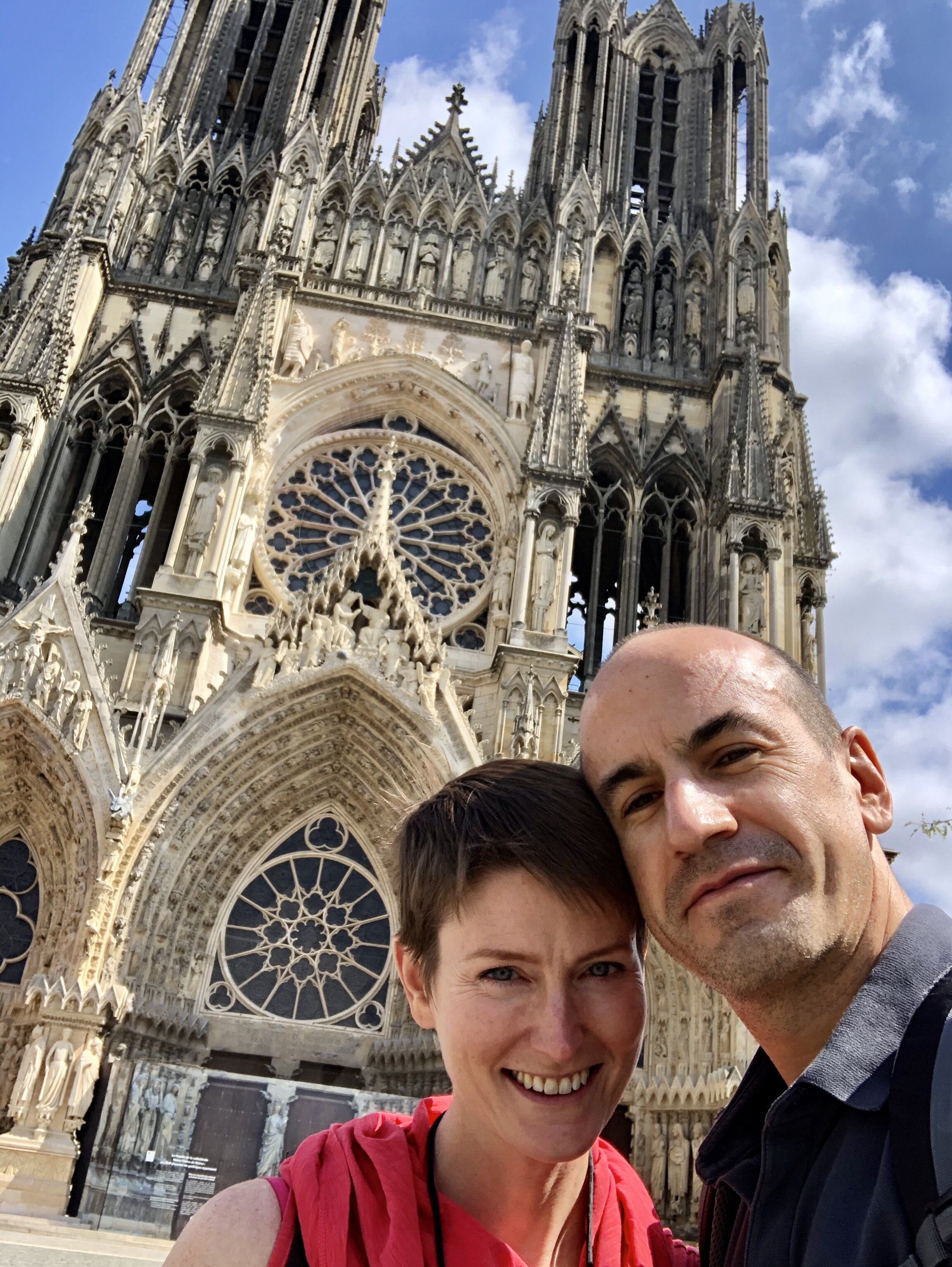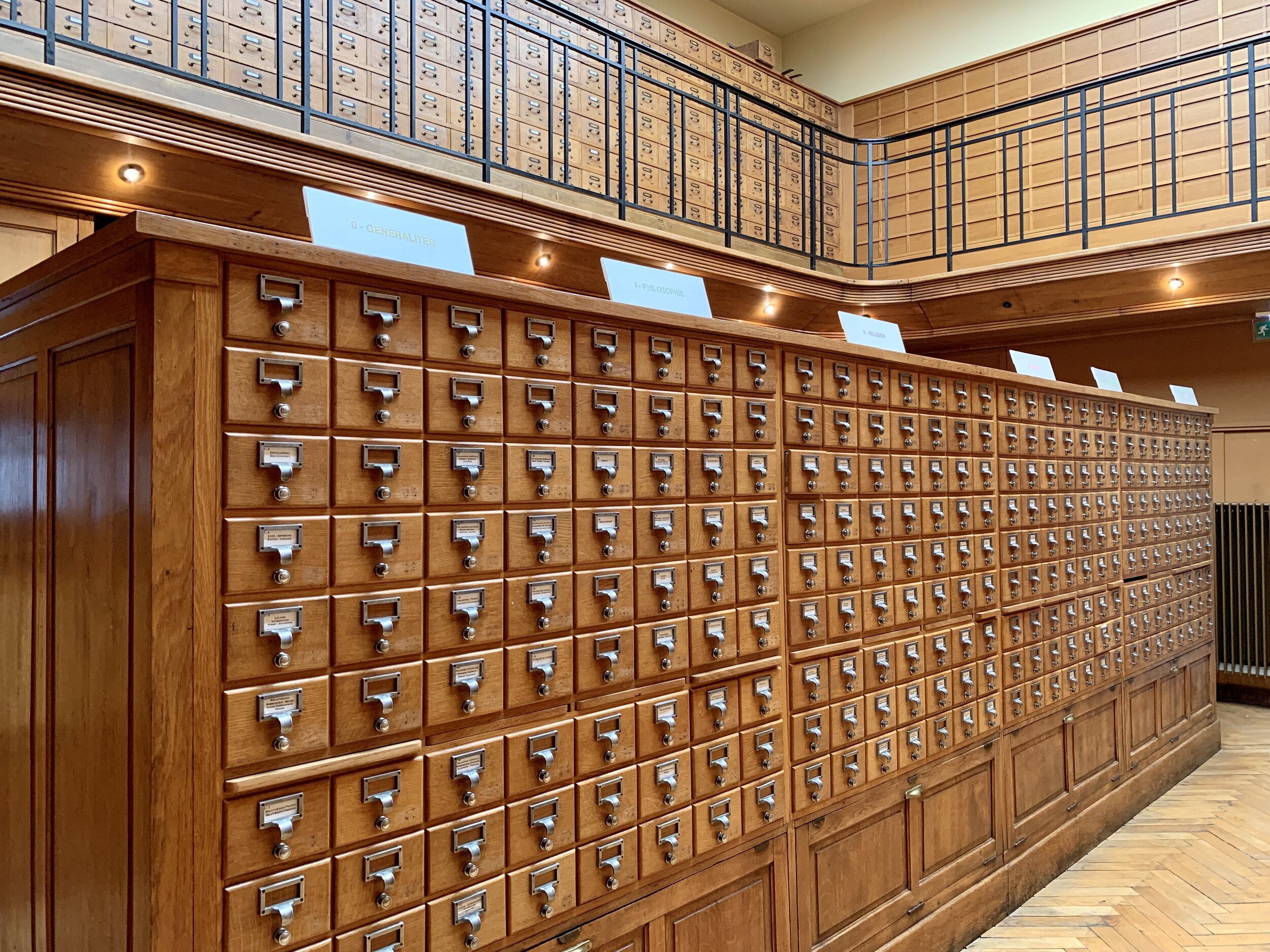A Day Trip to Reims, France: Kings, Churches, and Art Deco
The Hotel de Ville in Reims, France. August 14, 2020.
We spent a day in Reims, France, as part of a trip to the Champagne region of France (with a jaunt over into Burgundy to see a few castles, of course), during which we based ourselves in Troyes. Though we could easily have spent a weekend in Reims, we found that a day provided plenty of time for us to see the city’s major sites.
Reims has size: At nearly 200,000 people, Reims counts as one of the largest cities in France.
Alas, Reims received heavy damage during World War I—damage that almost completely razed the town. You can still see several sites that show bomb damage and, as you walk around, you’ll note many buildings with architectural features from before and after the wars in a single facade, presenting a mélange of history and quick, cost-effective, utilitarian after-war (known in France as “après guerre”) practicality.
Other than a few sites constructed in the popular art deco style of the 1920s, Reims’s WWI destruction and hasty reconstruction means that the city’s massive historical significance mostly feels muted.
The city’s lackluster efforts to highlight its sites and its place in the French and European story only exacerbate this sensation. We found very little explanation, few signs highlighting important places and stories, and not much by way of encouragement for touristic exploration and discovery.
In general, Reims feels dormant—especially for such a large and metropolitan city famed for its champagne cellars. Even the parts of the city that presented pedestrian-only shopping areas and outdoor terraces had few people in sight. That none of the direct routes between the major tourist sites lead to these pedestrian areas and that the city hasn’t created any signs pointing people to its retail centers doesn’t ameliorate the feeling of walking around a downtrodden, generic major urban area peppered with one or two main attractions.
However, you’ll benefit from a day or two in Reims—I promise. In fact, I’ve created this post to help you find the treasures we uncovered in Reims and to help you avoid our missteps. (If you do, you’ll undoubtedly love the city more than we did. We’ll go back in the future if only to create a better experience for ourselves in Reims.)
The Notre Dame Cathedral in Reims
The massive Gothic Cathédrale Notre Dame in Reims has played a significant role in French history, having served as the site of coronation for some twenty-five French kings over six centuries (between 1223 and 1825).
Alas, the cathedral was blasted by artillery in the first world war; pictures of it in the adjacent museum, the Palais du Tau, show a mere stone-wall hull remaining. In fact, so little stood of the cathedral after the end of the war that the citizens debated leaving it in ruins, rather than rebuilding. However, generous donations from the Rockefellers (yes, the ones from the United States) drew a new cathedral from the ashes.
Though the restorers did a beautiful job in creating a new cathedral, the structure does feel new—especially compared to the churches in nearby Troyes.
Worth a visit? In short, yes, though you won’t need to spend extensive time on site. The exterior will impress with its sheer size and the interior on a sunny day will show off the rose window to full splendor and the stained-glass windows designed by Marc Chagall in 1974, too.
The Palais du Tau
Nearby the cathedral—as in, right next door—you’ll find Reims’s famed Palais du Tau. Here, in the former archbishop’s residence, the French kings stayed awaiting coronation and returned after coronation to celebrate over feasts.
Unlike its neighboring cathedral, this palace mostly survived the wars in France, though its repurposing as a museum doesn’t effectively highlight its architectural or functional features. Instead, today you can see artifacts from kings’ coronations, especially the coronation of Charles X, and if you look carefully enough in the corner of one display cases and read all the descriptions of the items therein (surprisingly, the museum hadn’t highlighted it well, so only the sharp-eyed will catch it), you’ll find a jeweled necklace (called a “talisman”) worn by Charlemagne and taken off him during an exhumation.
Also, the museum provides photos of the cathedral before destruction and before rebuilding and memorabilia from the cathedral before its destruction, including surviving statuary and artifacts. As part of these artifacts from the cathedral and as an illustration of the level of heat and damage from the bombings, it presents several of the cathedral’s former gargoyles with lead from the burning roof structures, now hardened, pouring from their mouths.
In truth, the museum misses a lot of opportunities in addition to shrugging off its architecture and its rare treasures. It doesn’t do much to explain the rituals and process of French coronations, doesn’t give any history of the monarchy in France or of the kings crowned here, and mentions little about the functioning of the palace in its heyday.
The Basilique St-Rémi and the Musée St-Rémi
The Saint Remi Basilica in Reims managed to survive the war mostly intact as well; for this reason, it has much more historical profundity—to me—than the cathedral.
Front and center in the basilica, you’ll find buried in grand splendor Saint Rémi himself, someone of which you’ll have heard plenty in other Reims historical sites and other sites in the Champagne region, including Troyes.
The saint, a former bishop called Remigius, baptized a French king named Clovis (the first Catholic French king, thereby solidifying the union between the French government at the time and the Catholic religion) and thousands of Frankish soldiers way back in the fifth century. This saint, so they say, lived nearly a century—quite a feat back in the 400s-500s.
For me, the Saint Remi Museum connected to the basilica made the visit worthwhile: Here you’ll find a random agglomeration of stuff ranging a variety of seemingly unconnected subjects. You’ll find detailed dioramas of prehistoric people, gravestones of Romans, mosaic floors, and military gear. The museum provides a surreal treat; you never know what you’ll find in the next room.
A gorgeous tile floor from the very early middle ages, now preserved on the wall of the Saint Remi Basilica. Reims, France, August 14, 2020.
Art Deco Reims
An opportunity we missed: If you stop into the tourist office in Reims before or after your visit to the cathedral, you can pick up a map of art deco sites in Reims.
As we didn’t have the map to all the locations, we only knew to walk by the more renowned art-deco sites in Reims, including the Bibliothèque and the Halles du Boulingrin.
First, a brief history: Because Reims suffered such extensive damage during World War I and required extensive rebuilding, some sites (especially ones rebuilt thanks to donations from wealthy U.S. institutions, like the Carnegie Foundation) came to life in the art deco style of the 1920s. As art deco didn’t last long—a mere blink and we moved on to other styles—I loved seeing vestiges of its opulence.
The Halles du Boulingrin don’t warrant a visit unless you’re already nearby, but I’d classify the library as a can’t-miss sight in Reims. Though a petite building, you could spend a long time feasting your eyes on all the rarely seen elsewhere art-deco details.
The Famous Rose Biscuits of Reims
I’d read that Reims has culinary renown for its rose biscuits. I figured, as an intrepid explorer, I needed to try these famed rose biscuits while in Reims.
Traditionally, rose biscuits look like pink ladyfingers: Shaped like hot dogs cut in half, they get used in some desserts as a decorative and functional edge or foundation. Bakers gave them a rose tint back in the day to mask the flecks of vanilla bean used for flavor.
My review: What flavor? Pass on these. I even tried two varieties, in case I’d chosen the wrong bakery at the outset. In taking your taste buds elsewhere, you won’t miss anything but the disagreeable sensation of eating sugary dust pressed into cookie form.
Organizing Your Day in Reims
You’ll find the Reims tourist office near the cathedral. Start there, as we should have. While there, you can buy a pass to see all the major sites in Reims for a discount, you can get a walking-tour map of the city and its art deco sites, and you can learn about any day-of-visit events taking place, including any festivals, markets, and guided tours.
As starting at the Reims tourist office will place you near the cathedral, head there from the tourist office and then go next door to the Palais du Tau. (Note: If you’ve an interest in the art deco design, you’ll find the Bibliothèque a few steps away from these two major sites.)
For lunch and a midday break in sightseeing, walk over to the Place du Forum, where you’ll find plenty of restaurants, cafes, bars, and tearooms for a rest; stores and boutiques (albeit mainly French and European chains) for window gazing or shopping; and activities for kids including a merry-go-round.
After a pause, hike south past the cathedral down to the Saint Rémi basilica and museum, where you can wrap up the day.
Is Reims, France, Worth a Visit?
In short: Yes.
Though Reims doesn’t have the architectural splendor or charm of many other cities in France due to the damage it received in World War I, it has several treats worth seeing if you spend time in the Champagne region. (Just take a pass on the rose biscuits.)






















